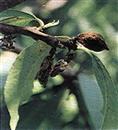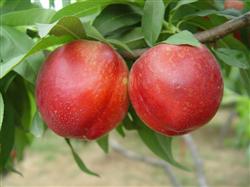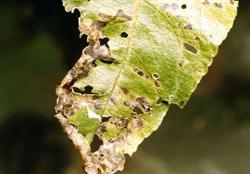Management techniques of nectarine in summer

First, the ability to control the vigorous growth of branches and prevent nectarines from closing in orchards is strong, and it is easy to produce secondary or even tertiary branches. in addition, nectarine trees are strong, especially the number of overgrown shoots before fruiting is large, which often leads to the deterioration of light in the orchard and the outward movement of fruit color. the yield is reduced. Therefore, attention should be paid to control in production, and the main control measures are as follows: (1) to strengthen the control of fertilizer and water. Especially for the control of nitrogen fertilizer, do not apply too much nitrogen in the early growth stage and after fruit harvest each year, so as to prevent the branches from growing. (2) controlled by plant hormones. The control effect was better when 5 g paclobutrazol was applied in the annular ditch under the new shoot growth period or sprayed on the trees in the new shoot growth period (200m ~ 300) × 10 ~ 5m ~ 615%. (3) sprouts should be wiped in time. The useless secondary branches, tertiary branches and buds on the back should be erased in time. If it is not erased in time, the branches should be thinned in time to keep the crown permeable. (4) keep the uniaxial extension of the branch group and reduce the number of branches. Second, strengthen flower thinning and fruit thinning in order to increase fruit because the fruit setting rate of nectarine is high, if the fruit can not keep up with it in production, the fruit will become smaller and affect the commerciality of the fruit. Therefore, in production, we should strictly thinning flowers and fruits, according to the growth strength of fruiting branches, timely thinning flowers and fruits in the early flowering period, leaving 6 flowers for each strong branch, 3 fruits for each strong branch, 4 flowers for the middle branch, 2 flowers for the middle branch, 2 flowers for the short branch and bouquet-like branches, and single fruit, so as to ensure that the fruit remains about 120 per square meter, so as to fully expand the fruit and improve the commerciality of the fruit. Third, improve the light of the tree and promote the coloring of the fruit. Because the nectarine tree is prosperous, it can be branched many times a year. If it is not controlled properly, it is easy to lead to poor fruit coloring, especially the poor coloring of the inner chamber and the lower part of the crown. Therefore, measures should be taken to promote coloring in production. The main results are as follows: (1) the character "ya", which is sensitive to light and high yield, should be chosen as the main tree shape. (2) it is necessary to wipe the buds and remove the sprouting in time during the budding period, and cut off the secondary and tertiary branches in time during the growing period, so as to control the number of branches and prevent the deterioration of light. (3) at the beginning of fruit coloring, the shading leaves were removed to make the fruit fully bathed in light. (4) during the fruit coloring period, branch pulling treatment was carried out to increase the light exposure of the inner chamber of the crown. (5) laying reflective film underground to improve the utilization of reflected light. Fourth, strictly prevent fruit rust, keep fruit surface smooth nectarine due to hairless, fruit rust is very easy to infect, fruit rust occurs, commerciality is reduced, affecting the improvement of production efficiency. Therefore, in order to strengthen the prevention and control, we should do the following: (1) strictly control the number of branches, keep the garden unobstructed, reduce the air humidity in the garden, and restrain the occurrence of diseases. (2) fruit bagging for fruit protection. (3) to carry out chemical protection, in rainy years, when there is high humidity in the garden, the 2000 times liquid of 25% wettable chlorothalonil powder or 65% wettable zinc powder 500 times liquid, 2% agricultural resistance "120" 200 times solution should be used in time to keep the fruit surface clean and improve the marketability of the fruit. Generally, the above pesticides should be used alternately every 7 days or so to control the harm. Fifth, promote fruit sugar accumulation and increase fruit flavor nectarine production is easy to appear flavor weakening phenomenon, the reason is mainly due to excessive water supply or unreasonable fertilization and early harvest, the ways to increase flavor are as follows: (1) limit water supply. Especially in the fruit expansion period, if not too dry, do not easily irrigate, in order to increase the accumulation of substances in the fruit, increase the fruit flavor. (2) increase material supply. Special attention should be paid to the application of organic fertilizer to increase tree nutrition. When coloring the fruit, appropriately increase the times of foliar fertilization and focus on spraying potassium fertilizer to promote the accumulation of sugar in the fruit and make the fruit sweeter. (3) it should be harvested on time. At the beginning of the fruit coloring period, the fruit begins to enter the period of nutrient accumulation, the longer the fruit growth time, the more nutrients accumulated, the sweeter the fruit taste, so it should be harvested in time.
- Prev

Key points of nectarine cultivation techniques
The cultivation techniques of nectarine are basically the same as those of other peach trees, but in order to successfully retain the characteristics of this variety and achieve high and stable yield, the main points of cultivation techniques are drawn up as follows: 1. Nectarine site selection has the following characteristics: 1. Nectarine has the characteristics of early germination and flowering, like sunshine, not tolerant to shade, afraid of flooding, not suitable for clayey soil, etc.
- Next

New countermeasures to skillfully control nectarine diseases and insect pests
The main diseases in the growing period of nectarine are bacterial perforation and brown spot perforation, which were sprayed with "New High Lipid membrane" + 70% methyl topiramate wettable powder 800 times and 65% Dessen zinc wettable powder 500 times. The main insect pests are aphids, red spiders and so on. 3000 times of liquid of 10% aphid lice can be used. At the same time, cooperate with spraying new high.
Related
- Moge, come on! The staff of the peasant association in the producing area of cantaloupe were frightened when the crowd gathered.
- Causes and Solutions of low Fruit setting rate of Apple
- Symptoms and control measures of passion fruit virus disease
- Fruit growing lesson: how do apple orchards keep high yields?
- Can you build orchards in the mountains? What are the pros and cons?
- How to manage the coloring period of Crisson grape?
- This paper introduces the processing technology of two kinds of fig products.
- How much is a month for retired teachers in rural areas by 2020?
- How can strawberry planting increase sugar content? We should pay attention to management in many aspects.
- What are the cultivation techniques on how to improve the yield of golden fruit?

